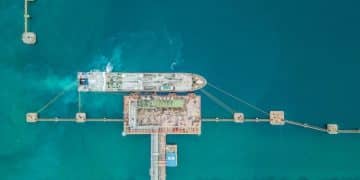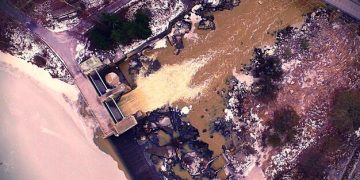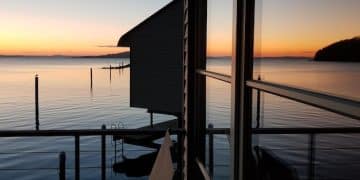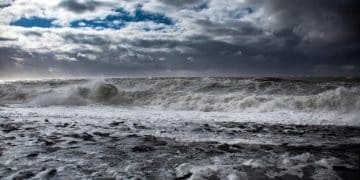Coastal Infrastructure Projects: Building Resilience Against Extreme Weather
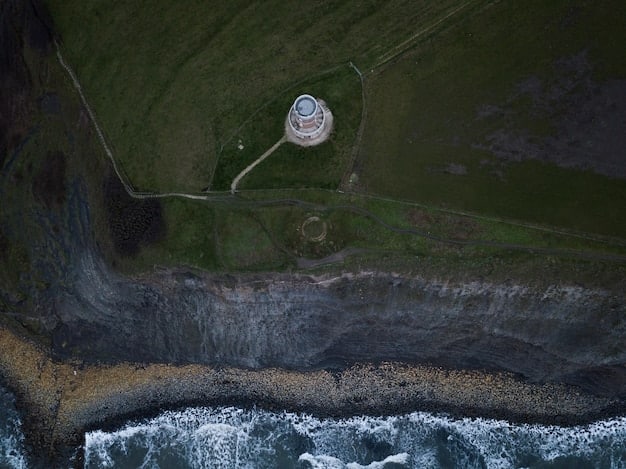
Coastal infrastructure projects are crucial for enhancing resilience against extreme weather events by integrating advanced engineering, sustainable practices, and strategic planning to protect communities and economies.
The increasing frequency and intensity of extreme weather events pose significant threats to coastal communities worldwide. From powerful hurricanes to rising sea levels, these phenomena demand robust and proactive solutions. This is where coastal infrastructure projects: improving resilience to extreme weather events become not just a necessity, but a critical investment in the future of our shorelines, aiming to fortify defenses and ensure the long-term sustainability of coastal regions.
The Imperative for Resilient Coastal Infrastructure
The vulnerability of coastal regions to climate change impacts is undeniable. Centuries of development, often without adequate foresight regarding environmental shifts, have left many coastal communities exposed. Now, with scientific consensus pointing to more extreme weather, the focus has dramatically shifted towards building infrastructure that not only withstands but also adapts to these challenges.
This paradigm shift involves a move from reactive repair to proactive fortification. It acknowledges that traditional defenses might no longer suffice against unprecedented storm surges and erratic weather patterns. The goal is no longer just to protect, but to build to endure and recover rapidly.
Rising Sea Levels and Intensified Storms
Two primary drivers underscore the urgency for improved coastal infrastructure: the relentless rise in sea levels and the intensification of tropical storms and hurricanes. These combined forces exert immense pressure on existing coastal defenses and natural ecosystems.
- Sea Level Rise: Leads to permanent inundation, increased frequency of high-tide flooding, and greater inland penetration of storm surges.
- Storm Intensity: Stronger winds, heavier rainfall, and larger storm surges amplify the destructive potential of individual weather events.
- Coastal Erosion: Exacerbated by both sea level rise and storms, leading to loss of land and increased vulnerability for beachfront properties and ecosystems.
The economic ramifications of inaction are staggering, with billions of dollars in potential damages to property, infrastructure, and livelihoods. Beyond economic costs, the social disruption and human displacement post-disaster highlight the urgent need for comprehensive resilience strategies. This section underscores the fundamental reasons why these projects are not optional, but essential.
Building resilient infrastructure is a complex undertaking, requiring not only significant financial investment but also a deep understanding of coastal dynamics, engineering principles, and community needs. It’s about creating systems that can absorb, adapt, and recover from shocks, minimizing disruption and ensuring the safety of populations. This often involves a blend of “hard” and “soft” engineering solutions, carefully selected and integrated for optimal effectiveness in specific coastal environments.
Innovative Engineering Solutions for Coastal Protection
Modern coastal engineering has moved far beyond simple seawalls. Today, a sophisticated array of solutions is being employed, integrating cutting-edge technology with ecological considerations. These innovations aim to create adaptive and multifaceted defenses that can withstand the diverse impacts of extreme weather events.
The design philosophy now emphasizes layered defense systems, where multiple strategies work in concert to attenuate wave energy, manage water flow, and protect vulnerable assets. This holistic approach ensures redundancy and enhances overall resilience, making coastal areas more robust against unforeseen challenges.
Hybrid and Nature-Based Solutions
A significant trend in coastal defense is the adoption of hybrid and nature-based solutions. These approaches leverage natural processes and ecosystems to provide protection, often with co-benefits for biodiversity and recreation. They represent a more sustainable and adaptable alternative to purely engineered structures.
- Living Shorelines: Using natural materials like oyster reefs, salt marshes, and mangroves to stabilize shorelines, filter water, and provide habitat, while also reducing wave energy.
- Dune Restoration: Rebuilding and fortifying natural sand dunes with vegetation to act as a primary barrier against storm surges and erosion.
- Offshore Breakwaters: Submerged or partially submerged structures that dissipate wave energy before it reaches the shore, often built with habitat-friendly materials.
These solutions are particularly appealing because they are often self-repairing to some extent and can adapt more naturally to changing environmental conditions than rigid structures. They also contribute to ecological health, supporting fisheries, improving water quality, and enhancing the aesthetic appeal of coastal areas. Their integration requires careful planning and a deep understanding of local ecological systems.
Beyond the natural solutions, advancements in traditional “hard” engineering are also playing a crucial role. Modern seawalls, levees, and floodgates are being designed with advanced materials and flexible designs to withstand greater forces and integrate better with urban landscapes. This often involves the use of high-strength, corrosion-resistant materials and designs that allow for future adaptive modifications.
Smart Technologies and Monitoring
The integration of smart technologies is revolutionizing how coastal infrastructure is designed, monitored, and managed. Real-time data collection and predictive modeling allow for more informed decision-making and dynamic responses to weather events.
Fromセンサー networks that monitor water levels and wave heights to AI-powered models that predict storm trajectories and flood risks, technology is empowering coastal managers with unprecedented capabilities. This proactive stance enables timely evacuation orders, efficient resource allocation, and optimized deployment of temporary flood defenses. The insights gained from these systems also feedback into the design process, leading to continuous improvements in infrastructure resilience. The ability to monitor structural integrity and environmental changes in real-time is invaluable for maintaining and upgrading these critical defenses.
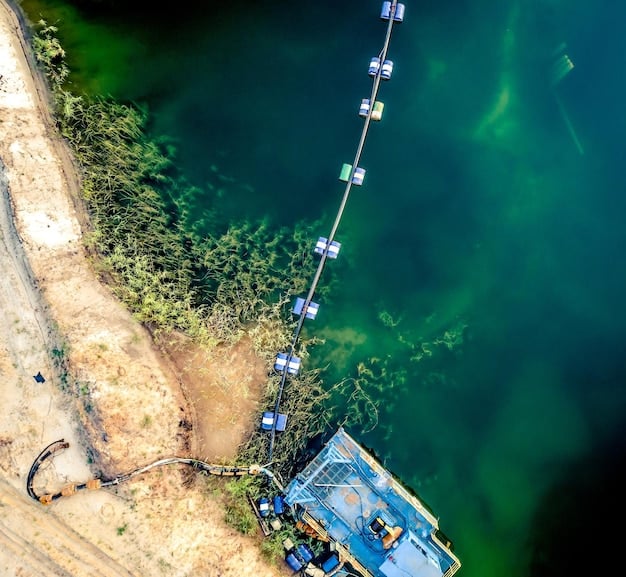
Case Studies: Success Stories in Coastal Resilience
Around the world, various coastal communities are implementing innovative projects to enhance their resilience against extreme weather. These case studies offer valuable lessons and demonstrate the effectiveness of diverse approaches, both in terms of engineering and community engagement.
Examining these real-world examples provides concrete evidence of what works, highlighting both the successes and the challenges encountered. They serve as blueprints and inspiration for other regions facing similar threats, showcasing the adaptive capacity of human ingenuity when confronted with environmental imperatives.
New Orleans, Louisiana: Post-Katrina Reinforcement
Following the devastation of Hurricane Katrina in 2005, New Orleans undertook one of the most ambitious coastal protection projects in U.S. history. The multi-billion dollar investment focused on creating a robust hurricane defense system, integrating a complex network of levees, floodwalls, gates, and pumps.
- Improved Levee System: Construction of higher and stronger levees and floodwalls, designed to withstand a 100-year storm event.
- Automated Floodgates: Installation of massive, automated gates at strategic waterways to prevent storm surge intrusion.
- Pumping Stations: Upgraded and expanded pumping capacity to quickly remove floodwaters from urban areas.
This monumental effort not only rebuilt a city traumatized by disaster but also set a new standard for urban flood protection. It demonstrated the critical importance of a layered defense system and the commitment required to protect vulnerable populations. The project continues to evolve, incorporating lessons learned and adapting to new climate projections, showcasing an ongoing commitment to resilience. The blend of federal and local efforts has created a much more secure urban environment.
The Netherlands: Pioneering Delta Works
The Netherlands, a nation largely below sea level, has centuries of experience managing water. Its Delta Works project, initiated after the devastating 1953 North Sea flood, is a globally recognized benchmark for large-scale coastal defense. This project exemplifies long-term strategic planning and engineering excellence in flood protection.
The Delta Works comprise a series of dams, sluices, locks, dikes, and storm surge barriers designed to protect the country’s low-lying areas. It’s a prime example of anticipatory infrastructure development, where the nation consistently invests in its water management systems to stay ahead of environmental threats. This continuous adaptation ensures the system remains effective in the face of evolving challenges.
While the scale of the Delta Works is unique, the principles of integrated water management, adaptive design, and continuous investment are highly transferable. The Dutch approach emphasizes flexibility and a blend of structural and non-structural measures, including spatial planning and early warning systems. This integrated philosophy provides a comprehensive framework for national resilience.
Challenges and Considerations in Project Implementation
Despite the clear benefits, implementing large-scale coastal infrastructure projects is fraught with challenges. These range from securing adequate funding and navigating complex regulatory frameworks to addressing environmental concerns and engaging diverse stakeholders.
The protracted nature of many of these projects also means they must contend with shifting political priorities, technological advancements, and evolving climate science. Successful implementation requires not just engineering prowess, but also robust governance, effective communication, and a long-term vision.
Funding and Political Will
One of the most significant barriers to initiating and completing coastal resilience projects is securing consistent and adequate funding. These projects often require billions of dollars and extensive timelines, making them susceptible to political changes and economic downturns.
- Federal and State Grants: Reliance on governmental appropriations, which can be inconsistent.
- Local Tax Bases: Limited capacity for large infrastructure investments in many coastal communities.
- Public-Private Partnerships: Increasing exploration of private sector involvement, though challenges remain in risk sharing and profitability.
Building political consensus and sustained public support are crucial for overcoming these financial hurdles. Long-term planning, bipartisan commitment, and innovative financing mechanisms are essential to ensure these vital projects move forward without debilitating delays. Without a strong, unified commitment from all levels of government, even the most innovative plans can falter, underscoring the political dimension of these engineering endeavors.
Environmental and Social Impacts
While designed to protect, some infrastructure projects can paradoxically have negative environmental and social impacts if not carefully planned and executed. Balancing the need for protection with ecological preservation and community interests is a delicate act.
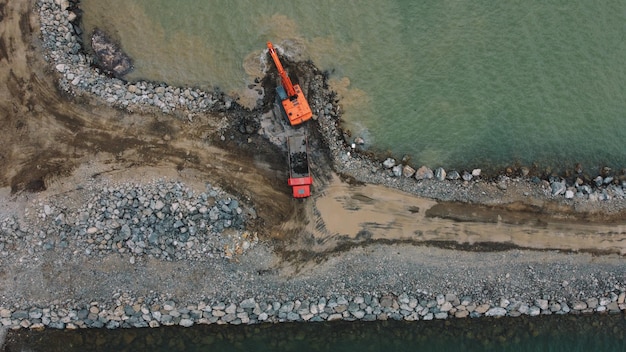
Ecological disruptions can include habitat destruction, alteration of natural sediment transport, and impacts on marine life. Socially, projects may lead to displacement, limited public access to the coast, or disproportionate impacts on vulnerable communities. Careful environmental impact assessments (EIAs) and robust public consultation processes are vital to mitigate these potential downsides. The goal is to maximize benefits while minimizing adverse effects, ensuring that resilience efforts do not create new problems. Engaging local communities early and genuinely helps address concerns and incorporates local knowledge, fostering a sense of shared ownership and ensuring that projects are truly beneficial and equitable. This collaborative approach enhances the legitimacy and long-term sustainability of the projects.
The Role of Policy and Governance in Resilience
Effective policy and robust governance frameworks are foundational to successful coastal infrastructure projects. These elements provide the necessary structure for planning, funding, regulating, and integrating diverse resilience efforts across different jurisdictions and stakeholders.
Without clear policy directives and coordinated governance, projects can become fragmented, inefficient, and ultimately less effective. It is the framework provided by good governance that allows engineering solutions to be conceived, funded, and implemented in a coherent and sustainable manner, transforming disparate actions into a unified strategic approach.
Integrated Coastal Zone Management
Integrated Coastal Zone Management (ICZM) is a holistic approach that seeks to balance economic development, environmental protection, and social well-being in coastal areas. It’s a multidisciplinary strategy that aims to manage coastal resources sustainably.
- Cross-Jurisdictional Coordination: Fostering collaboration among federal, state, local, and tribal governments.
- Stakeholder Engagement: Involving diverse groups, including scientists, businesses, environmentalists, and local communities.
- Adaptive Management: Developing flexible plans that can be modified based on new information and changing conditions.
ICZM recognizes that coastal issues transcend administrative boundaries and require coordinated responses. By integrating land-use planning, disaster preparedness, environmental conservation, and economic development, ICZM creates a more resilient coastal environment. This comprehensive approach shifts away from siloed decision-making towards a more interconnected and responsive management style, ensuring that projects do not occur in isolation but are part of a larger, coherent strategy for coastal health and safety.
Adaptive Planning and Legal Frameworks
Given the dynamic nature of climate change, rigid, static planning is insufficient. Adaptive planning, supported by appropriate legal frameworks, allows for flexibility and iterative adjustments to coastal resilience strategies as new data emerges or conditions change.
Establishing clear legal mandates for coastal resilience, alongside mechanisms for regular review and modification of plans, ensures that infrastructure projects remain relevant and effective over their long lifespans. This includes zoning regulations that guide sustainable development, building codes that account for future climate risks, and legal provisions for managed retreat where necessary. These frameworks provide the stability and direction needed for long-term investments in resilience. The ability to pivot and adjust strategies in response to evolving threats is a hallmark of truly resilient planning, making the legal and policy frameworks as critical as the physical infrastructure itself.
The Future of Coastal Resilience and Adaptation
Looking ahead, the imperative for coastal resilience will only grow. The conversation is shifting from merely protecting existing assets to understanding how to live with a changing coast, potentially requiring transformative changes in how communities interact with their environment. The future holds both significant challenges and profound opportunities for innovation.
This forward-looking perspective emphasizes a broader range of solutions—from advanced engineering to societal adaptation—and highlights the need for continuous research, investment, and collaboration. It’s about building a sustainable future where human populations and natural systems can coexist and thrive in a world of increasing climatic uncertainty.
Integrating Climate Change Projections
Future coastal infrastructure must be designed not just for current conditions but for projected future climate scenarios. This means incorporating the latest scientific understanding of sea level rise, storm intensity, and other environmental factors into every stage of planning and design.
- Dynamic Modeling: Utilizing sophisticated models to simulate future coastal conditions and evaluate the performance of proposed infrastructure.
- Scenario Planning: Developing strategies that are robust across a range of possible future climate outcomes.
- Flexible Designs: Incorporating features that allow for future expansion, modification, or even relocation as conditions evolve.
This approach moves beyond historical data to embrace predictive insights, ensuring that today’s investments are future-proofed against anticipated changes. It requires a willingness to embrace uncertainty and build in adaptive capacity from the outset. By integrating these projections, coastal communities can develop infrastructure that serves not just the immediate future but generations to come, standing as a testament to anticipatory governance. This foresight is crucial to prevent the creation of infrastructure that quickly becomes obsolete.
Community Engagement and Social Equity
Ultimately, the success of coastal resilience efforts hinges on meaningful community engagement and ensuring social equity. Projects must serve the needs of all residents, particularly those most vulnerable, and foster a sense of shared responsibility for coastal stewardship.
Engaging communities early and often in the planning process builds trust, incorporates local knowledge, and ensures that solutions are culturally and socially appropriate. Addressing issues of social equity means ensuring that the benefits of resilience projects are equitably distributed and that vulnerable populations are not disproportionately burdened by their implementation. This people-centered approach transforms technical projects into community-driven initiatives, strengthening social cohesion as much as physical defenses. True resilience is not just about physical structures; it’s about empowered and informed communities ready to face the future together. It is an investment in social capital as much as physical capital, creating robust communities capable of collective action.
| Key Point | Brief Description |
|---|---|
| 🌊 Enhanced Protection | Modern infrastructure projects use advanced designs and materials to defend against rising sea levels and intense storms. |
| 🌿 Nature-Based Solutions | Integration of living shorelines, dunes, and mangroves offers sustainable and ecological co-benefits. |
| 🔬 Smart Technology Usage | Real-time monitoring and predictive modeling improve response and management of coastal hazards. |
| 🤝 Community & Policy | Success depends on robust policy, integrated management, and equitable community engagement. |
Frequently Asked Questions About Coastal Resilience Projects
▼
Nature-based solutions leverage natural systems like living shorelines, mangrove forests, and restored dune systems to protect coastal areas. These approaches often provide ecological benefits such as habitat creation and water quality improvement, while also dissipating wave energy and reducing erosion, offering a sustainable alternative or complement to traditional “hard” infrastructure.
▼
To address rising sea levels, coastal infrastructure projects employ strategies such as elevating existing structures, constructing higher and stronger seawalls and levees, and implementing “managed retreat” policies. They also integrate future sea level rise projections into their designs, ensuring long-term effectiveness. Flexible designs that can be adapted over time are critical for sustained protection.
▼
Technology plays a crucial role through real-time monitoring systems, predictive modeling, and smart sensor networks. These tools provide invaluable data on ocean conditions, storm trajectories, and structural integrity, enabling quicker, more informed responses and better long-term planning for maintaining and optimizing coastal protection systems against extreme weather events.
▼
Funding coastal resilience projects presents significant challenges due to their high costs and long timelines. Reliance on inconsistent federal and state grants, limited local tax bases, and difficulties in establishing viable public-private partnerships are common hurdles. Sustained political will and innovative financing mechanisms are essential to overcome these substantial financial barriers and ensure project completion.
▼
Community engagement is vital because it builds trust, incorporates local knowledge, and ensures that resilience solutions are appropriate for the people they serve. It helps address concerns about environmental or social impacts, fosters a sense of shared ownership, and ensures that projects are truly equitable and effective. Engaged communities are more resilient both socially and physically.
Conclusion
The journey towards enhancing coastal resilience is multifaceted, integrating advanced engineering, forward-thinking policy, and robust community engagement. As extreme weather events intensify and sea levels continue to rise, the imperative for strategic investment in coastal infrastructure projects: improving resilience to extreme weather events becomes ever more critical. These efforts are not merely about erecting barriers but about fostering adaptable, sustainable, and thriving coastal communities that can withstand the profound environmental shifts of our era. The future of our coastlines depends on our collective will to invest wisely, plan comprehensively, and innovate continuously, ensuring the safety and prosperity of generations to come.

